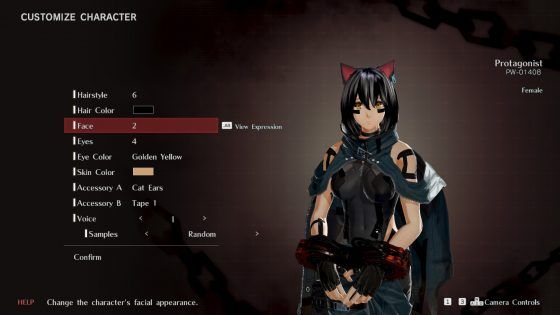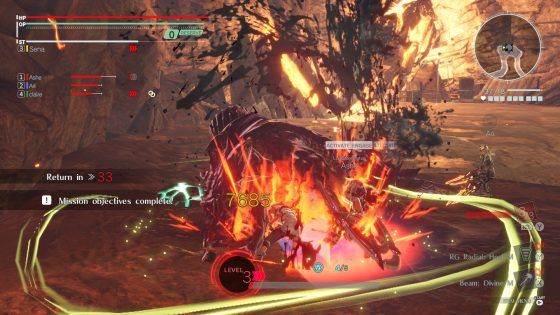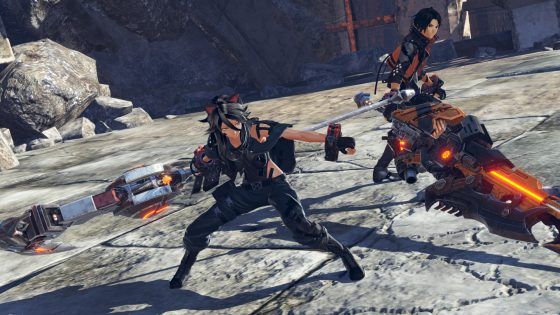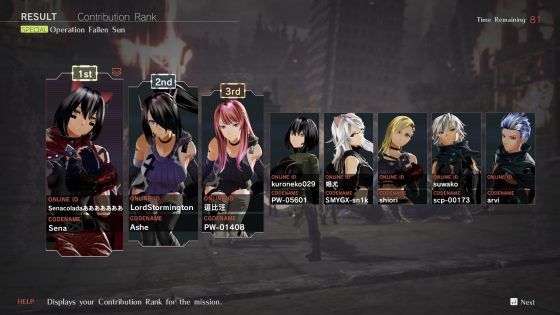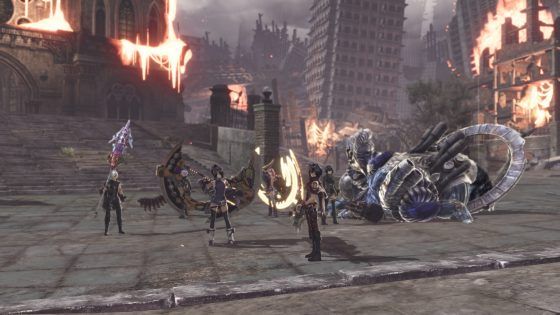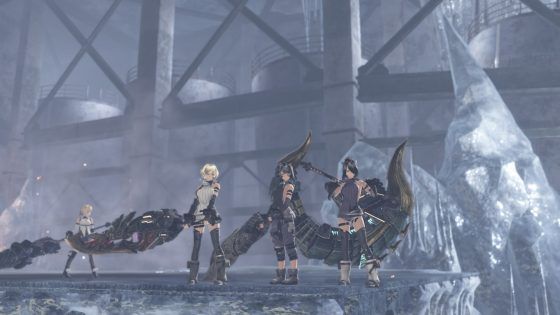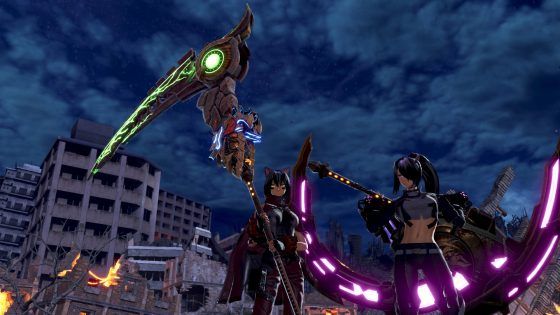God Eater 3 is a hunting-style action RPG developed by 'MARVELOUS!' and published by BANDAI NAMCO Entertainment. While not exactly the third game in the series due to a myriad of spin-offs, it was the first to be developed for current consoles and the PC instead of the usual remasters from its handheld counterparts. The game is pitted in the same vein as Monster Hunter, albeit flaunting its own visual flair and originality that lets it stand out as its own game. As with its hunting kin, you'll be tracking and farming horrendous beasts, which in this game comes in the form of the Aragami.
Players take the roll of an Adaptive God Eater (AGE), who are soldiers capable of withstanding the high levels of Ash found in the Ashlands. These individuals are also bred to be proficient in hunting the Aragami, as they wield the mainstay weapons in the series known as the God Arc, which are a collective of living weapons classified as an Aragami mixed with man-made technology.
The game's narrative is a bit lackluster at best, with pacing issues that fail to deliver the gravity it tries to convey, oftentimes pulling you out of the experience. The world itself is quite interesting, with you and a brigade of human weapons finding yourselves in the middle of opposing factions, each with their own way of dealing with the Aragami infestation. This becomes even more of a problem as you are joined by Phym, a young scantily clad girl who is not only crucial to the overall storyline, but is also my main source of awkwardness in the game.
The story does have a good premise to work with but tends to fall flat during moments that matter the most. One moment you're thinking about the long-term effects of what had just occurred, only to feel silly for even caring about it after the next mission when said consequences are lifted. The game just makes it hard for me to care about the cast. Of course, I didn't really expect much from the story, as these games tend to be a bit more gameplay-oriented, and boy did I have fun with God Eater 3.
Gameplay: 8/10
Despite its many similarities with other hunting titles, God Eater 3's combat is paced a lot faster than its kin. It gives players a more free-form hack-n-slash approach to Aragami slaying as opposed to the precision-based strikes found in the Monster Hunter series. You'll find yourself spinning up and around bosses while landing your attacks a-la Devil May Cry. That makes for some interesting fun as you test out the plethora of weapon types available in your arsenal.
Another feature that really stood out for me was flexibility of the God Arcs as weapons. Unlike Monster Hunter where players commit to a certain weapon type, God Arcs are able to switch from shield to melee and ranged weapons seamlessly during combat. You can even change your ranged weapon's bullets on the fly, allowing you to dish out more damage by equipping the right elemental weakness for each encounter. Ranged weapons are also capable of healing allies, as well as shoot Burst shots that instantly fill their Burst meter.
After investing a gratuitous amount of time in Monster Hunter titles, I found the drastic change in speed to be quite influential in how the game differs itself from its competitors. Soaring through the air while hitting enemies felt quite satisfying, considering that committing to dozens of animation locks is present in every hunting game to date. My biggest complaint, however, comes in the form of how lenient the game's challenges are. In fact, you'll find it hard to fail a mission despite reaching far in the game. Even if you brute force your way through content, you'll seldom change the way you tackle bosses. There are more than enough healing items to last you for the duration of the hunt. I'm not saying that games like these should be hard to make an impact, however, the Aragami just start to feel more like pushovers instead of the threat they were portrayed as, making your fight against them feel insignificant in the long run.
Simply put, I think the Aragami's impact towards the player feels rather light and cheap, as it's not really their strength as monsters that makes them memorable, but rather the fact that you'll identify with them simply because you've seen so many palette swaps of the same Aragami throughout your journey.
The game's gear upgrade system is just as you would expect from a hunting-action RPG, with weapons sporting their own upgrade trees that expand as you hunt and collect more Aragami parts. Despite some of the cons I've stated earlier, the game's upgrade system brings a lot of welcomed intricacies to the table. This increases the flexibility of experimentation when testing various builds even after reaching the endgame.
Unlike other games that lock you with a particular set of skills per equipment, God Eater 3 expands this aspect by granting players the ability to customize their attacks to further fit their playstyle. This is done by equipping Burst Arts along with sub-effects that greatly change the properties of specific moves. These upgradable skills become accessible by entering Burst mode, which is attained by performing an uninterrupted Devour attack. This gives players a nice dilemma of whether to continue attacking or take a bite to save their Burst meter for a better window of opportunity.
In addition to that, you can also equip Burst control units, granting your character passive buffs that further complement your battle tactics. There are also Acceleration triggers that boost your character relative to what trigger you chose by performing certain conditions throughout the encounter.
Last but not the least, we have Engage effects. I really appreciate how team oriented the game is, and how it just goes full on anime by having the power of friendship strengthen your combat abilities. Upon filling your Engage bar, you can activate the Engage effect, which tethers you to your teammate and shares your chosen Engage effects with them. You'll also sync your Burst meters, making for some easy meter management in the middle of a fight.
Some Missed Opportunities
When I heard that the game supports 8 player raids (Assault Missions), I immediately thought of how awesome it would be to take down a giant Aragami in over-the-top anime fashion with a large group; however, what I got were five-minute fights that discard all forms of strategic value.
To put it simply, Assault missions are speed run simulators where you and seven other players try to take down an Aragami within a span of five minutes. While it sounds overwhelming on paper, the fights are nothing but watered down versions of their original encounters. Since it's a race against time, dealing with it tank-and-spank style seems to be the way to go.
Throughout the many times I've run it, I've seen numerous people die to boss attacks, almost as if they're just trying to get as much damage in as possible. Much as it'd earn my ire when playing Monster Hunter, simply just hammering away without thinking seems to be the most optimal strategy for God Eater's Assault missions as opposed to composing yourself and studying its mannerisms needlessly lengthens the fight. I really wish they'd do more with it.
Another issue I would want to bring up is the game's severe lack of hit stun. Regardless of how big or blunt your weapons are, expect them to feel the same as a hot knife through butter. The monsters do stagger from time to time, but in most cases, the game fails in making you feel the overall impact of your attack. Always be on your guard and try not to sneak in some greedy hits. It's quite underwhelming, especially when huge critical damage numbers pop up on your screen and you see the monster unfazed by the blow.
The lock-on system also feels very clunky. Not only is it inconsistent with panning the camera but it's also extremely unresponsive. There have been numerous times where I found myself unable to switch targets despite having the giant Aragami right in front of me. It also seems to have a weird habit of locking on to enemies outside my peripheral vision. I guess a good tip would be to just not use it, unless there's only one Aragami on the screen. But on second thought, don't use it.
Innovation: 5/10
Considering how much the monster-hunting genre has flourished through the years, there were many instances where I found myself underwhelmed by the game's very dated system. The default controls were weirdly implemented for my taste and felt a bit counter-intuitive, with a lot of buttons being underutilized as it cramps up most of the functions on one side of the pad. A good example would be its 'Roll' button, which for some reason was mapped on the same button as 'Interact', leading to some mishaps when picking up items while traversing the map.
Speaking of maps, the game does very little with stage interaction, with jumping on vertical planes and picking up items on the ground as your only means of interacting with the various areas in the game. There really isn't much to talk about regarding the various maps other than how different they look, which takes a toll on the game's level of immersion. This makes the areas seem nothing more than nicely colored boxes made to house the encounter.
Another thing that feels dated are the lobbies. Don't get me wrong, the visuals look great, and the lobby music gets me pumped for the next mission, but the way people join and exit a game feels extremely dated. First, there is no drop in-out coop. Players must exit their current game and reform as a party every time a friend wants to join in. Exiting a game is another issue. The game doesn't simply tell you that your friend/teammate has gone offline; instead, people are subjected to a loading screen every time someone leaves, and it forces the ones left behind to rewatch the cinematic prior to the mission. This makes ending a session a bit of a hassle, as you'd often try to beat your friends out of exiting the game first.
Learning Curve: 9/10
God Eater 3 is very easy to get into. I wouldn't go as far as to say that it's hard to master, but there is enough complexity to keep players invested for a long time. There are not that many Aragami that require you to really alter your playstyle. It all boils down to knowing when to block or dodge. They do hit a lot harder as you progress in the game and are able to one-shot players who have low defense. Still, the lengthy campaign does its job well in preparing you for what lies ahead.
Graphics / Sound: 7/10
Built specifically for current consoles and the PC, the game has received quite a visual overhaul. By no means do God Eater 3's graphics standout, but the Aragami look more crisp and alive than they've ever been. It does its job well and is still pleasant to look at, given the whole anime aesthetic. The different God Arcs look amazing in HD, and the Aragami designs are top notch. Most areas do feel a bit bland, but I think that falls along the lack of interactable elements in the environment more so than the game's visual fidelity.
The soundtrack actually stood out for me, delivering various tracks that really boost the immersion for each fight. It was all very anime-like, and I do hope they add more tracks for upcoming Aragami, which they promised through future updates. The sound effects also deliver a satisfying crunch that highlights the impact of each swing, making those crits even more gratifying.
Value: 7/10
Priced at around $59.99, I have to admit that it still leaves much to be desired. They did say that God Eater 3 will be receiving numerous free updates and will skip the traditional Rage Burst incarnations, which was a good call seeing as it would be a bummer to buy a game twice simply for updates in this day and age.
Overall: 7/10
Overall, I really enjoyed playing God Eater 3. It's far from perfect but definitely a step in the right direction. Despite sharing the same genre as highly established franchises such as Monster Hunter, it does well in separating itself from the rest with its own set of unique mechanics and style of combat. The lock-on system can get a little frustrating, but it's nothing you can't get used to. The lineup of Aragami can be improved, but I know more encounters are coming in the future via patches. A little overpriced for what it's worth in its current stage, but it's a game I'd personally keep.
Pros:
Stylish fast-paced combat
Flashy aesthetics
Good amount of God Arcs to choose from
Good combat depth
Cons:
Cramped controls
Terrible lock-on system
Exiting the game on PC is a bit of a hassle for others
Combat could use some tweaking
